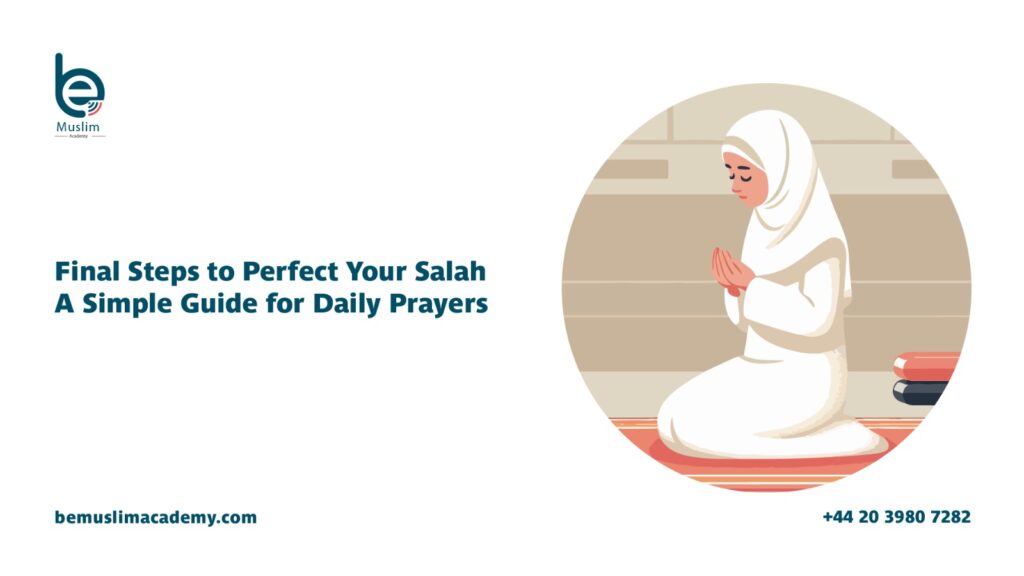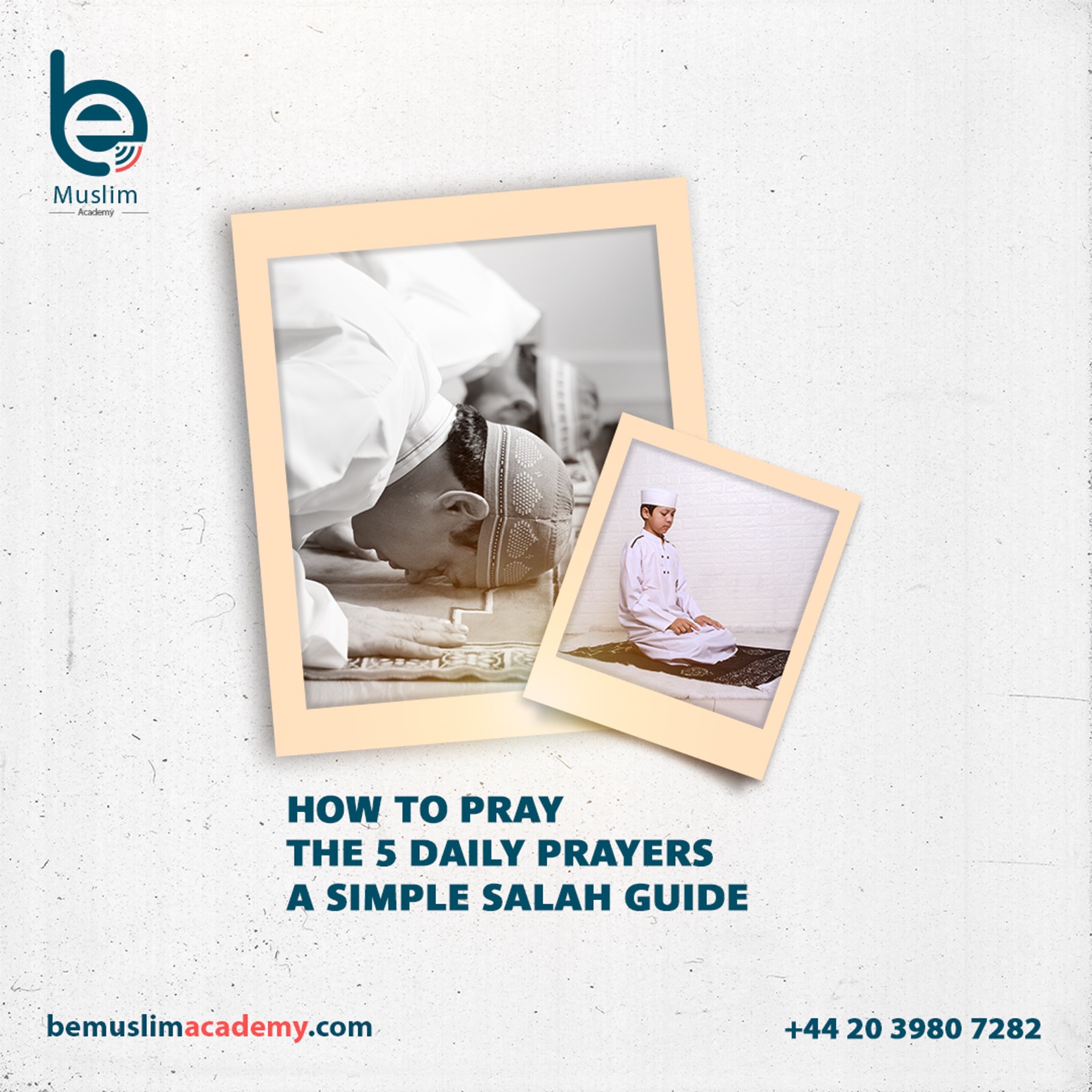Introduction: Why Salah Is the Backbone of Faith
How to pray the 5 daily prayers is a foundational practice every Muslim must learn and uphold. As one of the Five Pillars of Islam, Salah (prayer) serves as a direct connection between a Muslim and their Creator. Performing the five daily prayers not only strengthens our faith but also brings structure, mindfulness, and discipline into our daily lives.
What Are the 5 Daily Prayers in Islam?
Muslims are required to pray five times a day at specific times:
| Prayer Name | Time | Rakaat (Units) |
|---|---|---|
| Fajr | Before sunrise | 2 Rakaat |
| Dhuhr | After midday | 4 Rakaat |
| Asr | Afternoon | 4 Rakaat |
| Maghrib | After sunset | 3 Rakaat |
| Isha | Night | 4 Rakaat |
These 5 daily prayers are obligatory for every adult Muslim, male and female, and serve as a reminder of our purpose and connection to Allah throughout the day.
How to Prepare for Prayer
Before starting the Salah, a few important steps must be followed:
1. Perform Wudu (Ablution)
Wudu is the ritual washing to cleanse oneself before prayer. It includes washing the hands, mouth, nose, face, arms, wiping the head, and washing the feet.
🔗 How to Perform Wudu – Guide
2. Dress Modestly and Face the Qibla
Make sure your clothing covers the required parts of the body and is clean. Face the Kaaba in Makkah (known as the Qibla direction).
3. Find a Clean Place to Pray
Salah must be performed in a clean space. You can use a prayer mat, or any clean area indoors or outdoors.
Step-by-Step: How to Pray Salah
Below is a simple Salah guide for beginners to follow. We’ll begin with the Fajr Prayer (2 units):
🕌 Step 1: Niyyah (Intention)
Internally make the intention to pray a specific Salah. The Niyyah does not need to be spoken out loud.
🕌 Step 2: Takbiratul Ihram (Opening Takbir)
Raise your hands beside your ears (shoulders for women) and say:
“Allahu Akbar” (الله أكبر)
Meaning: Allah is the Greatest
🕌 Step 3: Recite Surah Al-Fatiha
This is the opening chapter of the Quran and is recited in every Rak’ah.
“Bismillah-ir-Rahman-ir-Rahim. Alhamdu lillahi Rabbil ‘alamin…”
🕌 Step 4: Recite Another Short Surah or Verses
Examples: Surah Al-Ikhlas, Surah Al-Kawthar, or any 3 short verses.
🕌 Step 5: Ruku’ (Bowing)
Bend forward with hands on knees and back straight. Say:
“Subhana Rabbiyal Adheem” (سُبْحَانَ رَبِّيَ الْعَظِيمِ)
Meaning: Glory is to my Lord, the Most Great
🕌 Step 6: Stand Up (Qawmah)
Stand straight again and say:
“Sami’ Allahu liman Hamidah, Rabbana lakal hamd”
🕌 Step 7: Sujud (Prostration)
Prostrate with forehead, nose, hands, knees, and toes on the ground. Say:
“Subhana Rabbiyal A’la” (سُبْحَانَ رَبِّيَ الأَعْلَى)
Meaning: Glory is to my Lord, the Most High
🕌 Step 8: Sit and then Repeat Sujud
Sit briefly and then do Sujud again. This completes one Rak’ah.
🕌 Step 9: Repeat for Second Rak’ah
In the second unit, after Sujud, sit for Tashahhud and say:
“At-Tahiyyatu lillahi was-salawatu wat-tayyibat…”
Then end the prayer after Salam by turning the head to the right and then left, saying:
“As-salamu alaikum wa rahmatullah”
Common Mistakes in Salah and How to Avoid Them
- ❌ Praying too fast – Always take your time and maintain humility.
- ❌ Not knowing the meaning – Learn the translations of what you’re saying.
- ❌ Losing focus – Remove distractions and concentrate on the words.

A Step-by-Step Guide on How to Pray the 5 Daily Prayers – A Simple Salah Guide
In this section of our Simple Salah Guide, we’ll walk you through exactly how to pray the 5 daily prayers in Islam—Fajr, Dhuhr, Asr, Maghrib, and Isha. Whether you’re a beginner, a new revert, or simply looking to improve your prayer, this comprehensive breakdown will simplify every step.
🌅 1. How to Pray Fajr – The Early Morning Prayer
Fajr is the first of the five daily prayers and has 2 Rak’ahs (units of prayer).
Time: From dawn (true Fajr) until just before sunrise.
Step-by-Step:
- Make Wudu (Ablution) – Ensure you are in a state of physical purity.
- Face the Qiblah – Direction of the Kaaba in Makkah.
- Intention (Niyyah) – In your heart, intend to pray Fajr (2 Rak’ahs).
- Takbir (Allahu Akbar) – Raise your hands and say “Allahu Akbar” to begin.
- Recite Surah Al-Fatiha, followed by another short Surah (e.g., Surah Ikhlas).
- Ruku’ – Bow with your back straight, say: “Subhana Rabbiyal Azeem.”
- Stand up (Qiyam) – Say: “Sami Allahu liman Hamidah – Rabbana lakal hamd.”
- Sujood – Prostrate and say: “Subhana Rabbiyal A’la.”
- Sit briefly, then make the second Sujood.
- Second Rak’ah – Repeat steps 5–9.
- After the second Sujood, sit for Tashahhud and complete the Tasleem:
- “Assalamu Alaikum wa Rahmatullah” (to the right and then to the left).
🔹 Special Tip: Fajr is accompanied by peace and serenity. Try to pray slowly and mindfully. It’s also a time when angels witness your prayer (Sahih al-Bukhari).
☀️ 2. How to Pray Dhuhr – The Midday Prayer
Dhuhr consists of 4 Rak’ahs.
Time: Starts when the sun begins to decline after midday until the shadow of an object is equal to its length.
Step-by-Step:
- Begin with intention for four Rak’ahs.
- Follow the steps as in Fajr, repeating Surah Al-Fatiha + a short Surah in the first two Rak’ahs only.
- In Rak’ah 3 and 4, recite only Surah Al-Fatiha.
- Sit for Tashahhud after Rak’ah 2 and again after Rak’ah 4.
- End with Tasleem.
📌 Tip: Dhuhr is often prayed during work or school hours. Find a quiet space and take this time as a spiritual reset.
🕒 3. How to Pray Asr – The Afternoon Prayer
Asr has 4 Rak’ahs, like Dhuhr.
Time: Begins when the shadow of an object exceeds its length and ends just before sunset.
Step-by-Step:
- Similar to Dhuhr, all steps are the same.
- The only difference is the time of prayer.
- Try to avoid delaying Asr until just before sunset, as it’s disliked (Makruh).
💡 Reminder: The Prophet ﷺ said, “Whoever misses the Asr prayer, it is as if he lost his family and wealth.” (Bukhari)
🌇 4. How to Pray Maghrib – The Sunset Prayer
Maghrib is unique with 3 Rak’ahs.
Time: Begins right after sunset and ends when the redness in the sky disappears.
Step-by-Step:
- First 2 Rak’ahs – Like Fajr, with Surah Al-Fatiha and another Surah.
- Sit for Tashahhud after the second Rak’ah.
- Third Rak’ah – Recite only Surah Al-Fatiha, then continue as usual.
- End with Tasleem.
📘 Extra Tip: Maghrib is often prayed quickly after breaking the fast during Ramadan. Still, focus and khushu’ are essential.
🌙 5. How to Pray Isha – The Night Prayer
Isha has 4 Rak’ahs.
Time: Starts when the red twilight disappears and ends at midnight.
Step-by-Step:
- Same format as Dhuhr and Asr.
- Surah Al-Fatiha + a short Surah in Rak’ahs 1 and 2.
- Only Al-Fatiha in Rak’ahs 3 and 4.
- Tashahhud after 2nd and 4th Rak’ah.
- Tasleem to end.
🔹 Optional: After Isha, it’s highly recommended to pray Witr (1 or 3 units) before sleeping. It’s a sunnah prayer that the Prophet ﷺ never abandoned.
Key Pillars to Remember in All 5 Daily Prayers
- Niyyah – Must be made before each prayer.
- Qiyam (Standing) – Essential when physically able.
- Qira’ah (Recitation) – Especially Surah Al-Fatiha.
- Ruku’ & Sujood – With proper remembrance.
- Tashahhud & Tasleem – Mark the end of your prayer.
Frequently Asked Questions (FAQs)
❓ What if I miss a prayer?
You must make it up as soon as possible (Qadha). Never intentionally delay a prayer beyond its time.
❓ Can I combine prayers?
Only in specific situations (travel, illness) and only Dhuhr with Asr, and Maghrib with Isha.
❓ Can I pray silently?
Yes, Dhuhr and Asr are prayed silently. Fajr, Maghrib, and Isha have audible recitation in the first two Rak’ahs (for men in congregation).
Conclusion: Keep Practicing
This Simple Salah Guide aims to show you exactly how to pray the 5 daily prayers—a fundamental duty for every Muslim. With consistent effort, focus, and sincerity, prayer will become the anchor of your life.
✅ Add This to Your Salah Journey:
- Quran.com – Learn Surahs for Prayer
- IslamQA.info – Reliable Islamic Rulings
- Be Muslim Academy – Prayer and Quran Courses
Tips for Perfecting Your Prayer & Overcoming Common Challenges

Mastering the Art of Khushu’: Praying with Focus
One of the most important goals in learning how to pray the 5 daily prayers is achieving Khushu’—a deep sense of humility, focus, and connection with Allah. Without Khushu’, your prayer may become a robotic ritual rather than a meaningful spiritual act.
Here’s how to improve your Khushu’:
- Eliminate distractions before prayer. Put your phone away, choose a quiet room, and make sure your mind is free from stress.
- Reflect on the meaning of the words you’re reciting. Understand the Arabic or read a translation before you begin.
- Visualize standing before Allah. Imagine He is watching and listening to you.
- Slow down your movements. Rushing through Salah reduces concentration. Move gracefully and intentionally.
- Make sincere Du‘a after prayer. Treat the prayer as a personal meeting with your Creator.
The Simple Salah Guide wouldn’t be complete without this inner dimension of prayer.
Common Mistakes and How to Avoid Them
When learning how to pray the 5 daily prayers, it’s important to identify and correct common mistakes:
1. Lack of Wudu (Ablution)
Many people forget the conditions of Wudu or perform it incorrectly. Always ensure:
- No part of the limb is left dry.
- You say Bismillah before beginning.
- The correct order of washing is followed.
2. Inconsistent Timing
Missing the prayer window invalidates the Salah. Use a prayer app or local Masjid calendar to track accurate times.
3. Incorrect Recitation
- Mispronunciation can alter meanings.
- Practice with a teacher or use apps with audio recitation to perfect your Tajweed.
4. Lack of Stillness in Movements
The Prophet ﷺ emphasized stillness between postures. Ensure:
- You pause after Rukū‘ before going into Sujūd.
- You sit calmly in between the two Sujoods.
5. Unfocused Mind
Mind wandering during Salah is common. Combat this by:
- Varying your recitation in different prayers.
- Focusing on the meaning behind each phrase.
Learning how to pray the 5 daily prayers is not just about mechanics—it’s about mindfulness.
How to Stay Consistent in Your 5 Daily Prayers
Mastering the Simple Salah Guide also means building consistency. Here are practical ways to never miss a prayer again:
Set Visual Reminders
Place Salah times on your fridge, work desk, or mobile lock screen.
Use a Salah App
Apps like Muslim Pro, Athan, or Pillars notify you with accurate prayer times based on your location.
Build a Prayer Routine
- Wake up early for Fajr, then plan the rest of your day around your prayer times.
- Group family members together at home to create a “mini-jama‘ah.”
Reward Yourself
After completing all 5 daily prayers consistently for a week, treat yourself to something small but meaningful.
Join Online Prayer Challenges
Many Islamic websites or YouTube channels offer 30-day Salah improvement programs. Accountability helps!
Women and Prayer: Special Considerations
The beauty of Islam is its inclusivity. While how to pray the 5 daily prayers is the same in core structure, there are some specific rulings for women:
- Menstruation/Postpartum Bleeding: Women are exempt from praying during this time.
- Prayer in Private: Women can pray at home and get the same reward as men praying in congregation.
- Dress Code: A woman’s entire body should be covered except for the face, hands, and feet during Salah.
Tips for women:
- Create a small, clean prayer area at home.
- Use a dedicated prayer outfit (jilbab or abaya) for consistency.
- Involve children in the process to foster early habit formation.
Salah and Children: Teaching the Next Generation
Instilling the habit of Salah in children is a powerful legacy. The Prophet ﷺ said:
“Command your children to pray when they become seven years old…” (Abu Dawood)
How to teach kids using the Simple Salah Guide:
- Lead by Example: Let them see you pray regularly.
- Make it Fun: Use colorful prayer mats, animated videos, or Salah stickers.
- Explain the Meaning: Use stories to explain why we pray.
- Praise, Not Pressure: Celebrate progress rather than punishing mistakes.
- Start with Fajr & Maghrib: These are shorter and easier to teach.
Create a prayer chart at home and let your child tick off each successful Salah. This builds motivation and spiritual discipline.
The Spiritual Rewards of Salah
Understanding how to pray the 5 daily prayers becomes more motivating when you remember the immense spiritual rewards:
- Fajr: Protects from Hellfire and is witnessed by angels.
- Dhuhr: Wipes away sins committed in the morning.
- Asr: A barrier between you and the Hellfire.
- Maghrib: Allows reflection at the close of the day.
- Isha: Prayer in congregation equals half a night’s worship.
Regular prayer:
- Purifies the heart.
- Builds a direct connection with Allah.
- Teaches discipline and time management.
- Serves as a source of comfort during hardship.
Integrating Salah into a Busy Modern Life
Modern Muslims face real challenges—jobs, studies, long commutes. But that doesn’t mean prayer should be compromised. Here are creative tips:
- At Work: Use your break to pray Dhuhr or Asr. Keep a portable prayer mat.
- At School: Ask teachers for a 5-minute prayer break—most are respectful if you explain its importance.
- Traveling: Use apps to find Qiblah direction and adjust prayer times for local zones.
- In Transit: You can pray sitting if you’re unable to stand (e.g., on a plane or train).
No matter where you are, how to pray the 5 daily prayers can be adapted into your routine.
Du‘a After Prayer: Strengthening the Bond
After completing Salah, you’re in a spiritually elevated state. Make Du‘a:
- Ask for forgiveness
- Thank Allah for guidance
- Pray for your family, community, and the Ummah
Use these Du‘a moments to form a deeper relationship with Allah.
Examples:
- “O Allah, make me among those who establish prayer and from my descendants.” (Qur’an 14:40)
- “O Allah, guide me and rectify my affairs.”
Your Du‘a reflects your personal journey, so make it heartfelt.
Final Reflections: The Beauty of Salah
Learning how to pray the 5 daily prayers is a lifelong journey. Whether you’re a beginner or returning to prayer after time away, the key is sincerity and consistency.
Let this Simple Salah Guide be your companion on this path. Every prayer brings you closer to your Creator. Every Sajdah (prostration) is a moment of mercy.
If you haven’t already, now is the perfect time to commit to Salah as your daily act of devotion and transformation.
🌙 Prayer is not a burden—it’s a gift. 🌙







